Zaliko Bodjadze - Qvevri Maker
by
Terry Sullivan
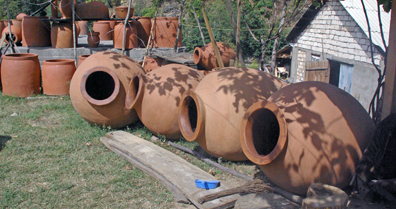 About two hours west of Tbilisi near the village of Makatubani is the shop of qvevri maker Zaliko Bodjadze. His shop is right next to the road and several qvevris rest on their sides. There are also number of terra cotta tones. The orange color of the fired earth is visible from a distance from the road announcing that a qvevri maker’s shop is near.
About two hours west of Tbilisi near the village of Makatubani is the shop of qvevri maker Zaliko Bodjadze. His shop is right next to the road and several qvevris rest on their sides. There are also number of terra cotta tones. The orange color of the fired earth is visible from a distance from the road announcing that a qvevri maker’s shop is near.
Zaliko Bodjadze explained what he does and answered our questions. We asked where he finds the clay for making qvevri. Zaliko said he goes up into the mountains. He believes the red clay in the mountains makes the best qvevris.
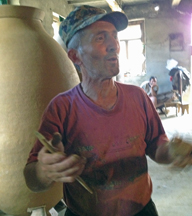 We proceeded into the shop where Zaliko took time to demonstrate adding a coil to the qvevri. Taking about a three inch thick clay coil, Zaliko used a
We proceeded into the shop where Zaliko took time to demonstrate adding a coil to the qvevri. Taking about a three inch thick clay coil, Zaliko used a 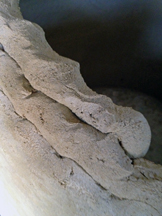 twisting motion to add a layer of clay to the qvevri. Several clay coils were needed to add a little over an inch to the circumference of the qvevri. He added two layers to the qvevri then took a flat piece of wood that resembles a spatula and smoothed the sides of the coils. Zaliko added two layers and smoothed the clay very quickly, a sign that he has been making qvevris for a long time. In three days he will add other layers. Other qvevris in the shop were standing upright air drying.
twisting motion to add a layer of clay to the qvevri. Several clay coils were needed to add a little over an inch to the circumference of the qvevri. He added two layers to the qvevri then took a flat piece of wood that resembles a spatula and smoothed the sides of the coils. Zaliko added two layers and smoothed the clay very quickly, a sign that he has been making qvevris for a long time. In three days he will add other layers. Other qvevris in the shop were standing upright air drying.
After the qvevris dry, they are taken to another nearby building where they a fired. The ovens are long and can hold several qvevris. The walk-in ovens have steel beams on the floor. Qvevris are placed on top of the beams. After filling the oven with qvevris, a temporary wall is built covering the opening of the oven. This wall was made with blocks and bricks cemented together. Dried tree roots were placed near the bottom where there was an opening in the wall. The roots would be set on fire and wood would be added to increase the temperature needed to file the qvevris.
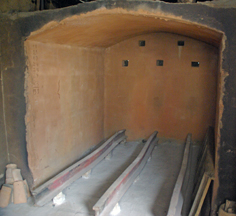
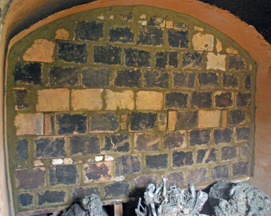
After several days the firing is complete. The temporary wall is taken down and the blocks and bricks will be reused again. Once the qvevris have cooled to about 170ºF, their interior is cleaned, then melted beeswax is added to seal the interior of the qvevri. We asked Zaliko at what temperature does he add the beeswax. He simply took his hand and touched the side of a qvevri. He can tell when to add the beeswax by touch. The beeswax seals the qvevri so wine will not leak out.
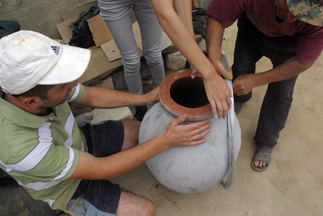 The qvevris are now ready for delivery to wineries. If the winery is closeby, a layer of lime cement is added to the outside of the qvevri. The cement adds to the strength of the qvevri and offers some protection from earthquakes. If the qvevris are to be shipped to another country, the cement is usually added by the winemaking staff since it does add weight to the qvevri. Zaliko demonstrated how he makes a grid out of wire before adding the cement to the outside of a qvevri. The wire also adds strength to the qvevri and makes it easier for the cement to adhere to the surface.
The qvevris are now ready for delivery to wineries. If the winery is closeby, a layer of lime cement is added to the outside of the qvevri. The cement adds to the strength of the qvevri and offers some protection from earthquakes. If the qvevris are to be shipped to another country, the cement is usually added by the winemaking staff since it does add weight to the qvevri. Zaliko demonstrated how he makes a grid out of wire before adding the cement to the outside of a qvevri. The wire also adds strength to the qvevri and makes it easier for the cement to adhere to the surface.
We asked about the cost of a qvevri. Zaliko mentioned that qvevris under 100 liters cost about $2.00 per liter. Over 100 liters the cost drops to $1.00 a liter. When compared to the cost of French oak barrels, qvevris are much less expensive. French oak barrels last for several years, whereas qvevris can last for several centuries.
Observing Zaliko work was like watching an artist. His movements were graceful and quick. The art of qvevri making continues at Zaliko Bodjadze’s shop. His son also makes qvevris and will continue with the family business.
Article written March 2014
